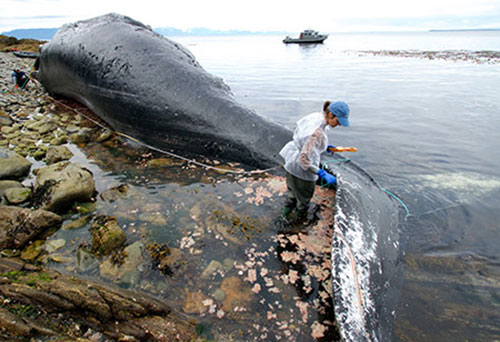
Scientists Perform Necropsy on Whale with Long History in Southeast Alaska
July 11, 2014
"The left mandible was fractured and the right mandible was traumatically dislocated from the cranium,” said Dr. Kathy Burek of Alaska Veterinary Pathology Services as lead veterinarian on the necropsy. “Cause of death was determined to be ship strike."
NOAA Fisheries Alaska Region Marine Mammal Stranding Coordinator Aleria Jensen measures the length of a female humpback whale during a necropsy near Funter Bay last week, while University of Alaska Fairbanks marine biology graduate student Suzie Teerlink holds the other end of the line.
When the team of nine—a captain, a gun bearer, a veterinary pathologist, marine mammal specialists, and volunteers—arrived on the scene Thursday, they saw an exposed jawbone and the fracture was immediately apparent. The team collected various tissue and organ samples from the carcass, including stomach contents. Analysis of the eye and ear plug should tell scientists her age. “Any and all samples from her will be extremely valuable given her long and very complete reproductive history,” said Christine Gabriele, a wildlife biologist with the Humpback Whale Monitoring Program at Glacier Bay National Park and Preserve, who has been following #539 for many years. “She’s a really interesting whale.” This particular humpback was first documented in Glacier Bay in 1975. According to the collaborative Southeast Alaska humpback whale database, she's had 5 calves between 1982 and 2005, and has at least 3 grand-calves. “She was seen regularly in Glacier Bay and Icy Strait,” added Janet Neilson, also with Glacier Bay’s Humpback Whale Monitoring Program. “Our last confirmed sighting of her was in 2012.” “It is rewarding to study such long-lived beings,” said Fred Sharpe, a scientist with the Alaska Whale Foundation who has also studied this humpback for many years. “By photographing their distinctively pigmented tails, we can learn much about an individual’s habits and social life.” Scientists who learned about humpbacks from following #539 for many years will now learn from her death. “We appreciate everyone's involvement to make this necropsy happen,” said Aleria Jensen, NOAA Fisheries Alaska Region marine mammal stranding coordinator. “It is a tragic event, but important to have such a clear cause of death to understand the factors impacting humpback whales.” Jensen added that this kind of ship strike mortality serves as a wake-up call for ocean users to be watchful while on the water. “With a recovering population, we are seeing more and more humpback whales every year. This is a reminder to take extra precaution when whales are in the area and slow your vessel’s speed. It’s the number one action to take to prevent ship strike.” Numerous studies have shown that slower speeds are less likely to result in injury or mortality to whales, damage to vessels, or injury to passengers. A 2006 study showed that the probability of lethal injury increased dramatically from 8.6 knots (21%) to 15 knots (79%). A 2012 study examining Alaska whale-vessel collision records found 108 collisions reported in Alaska from 1978–2011, most involving small vessels. In a third of the cases, human injury or property damage resulted from the collision, and a number of people were thrown into the water. NOAA’s Office of Law Enforcement is performing an investigation into the death of the humpback whale. Anyone with information relating to this incident should call the NOAA’s Office of Law Enforcement HOTLINE at 1-800-853-1964. “It would have been gratifying to see her once again diving and spouting among our inland seas,” said Sharpe. “Her calves survive her, may we always be vigilant to keep them safe.” The humpback whale approach regulation has been in effect since July 2001 and requires that you:
Federal law prohibits pursuit of marine mammals.
According to NOAA, if approached by a marine mammal:
Edited by Mary Kauffman, SitNews
Source of News:
|
||
